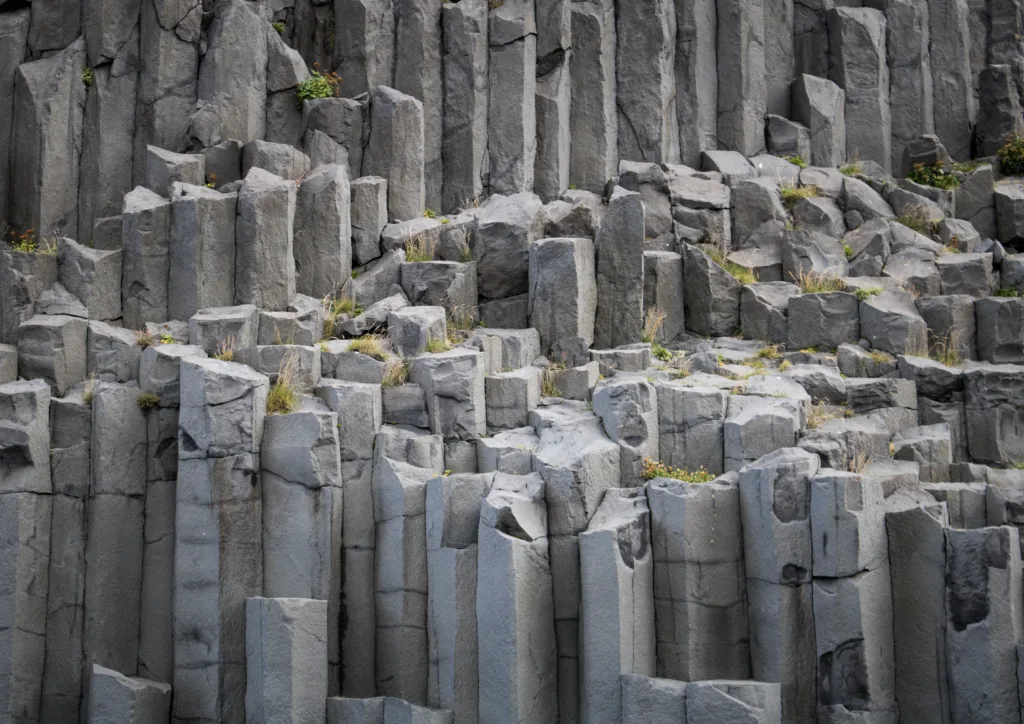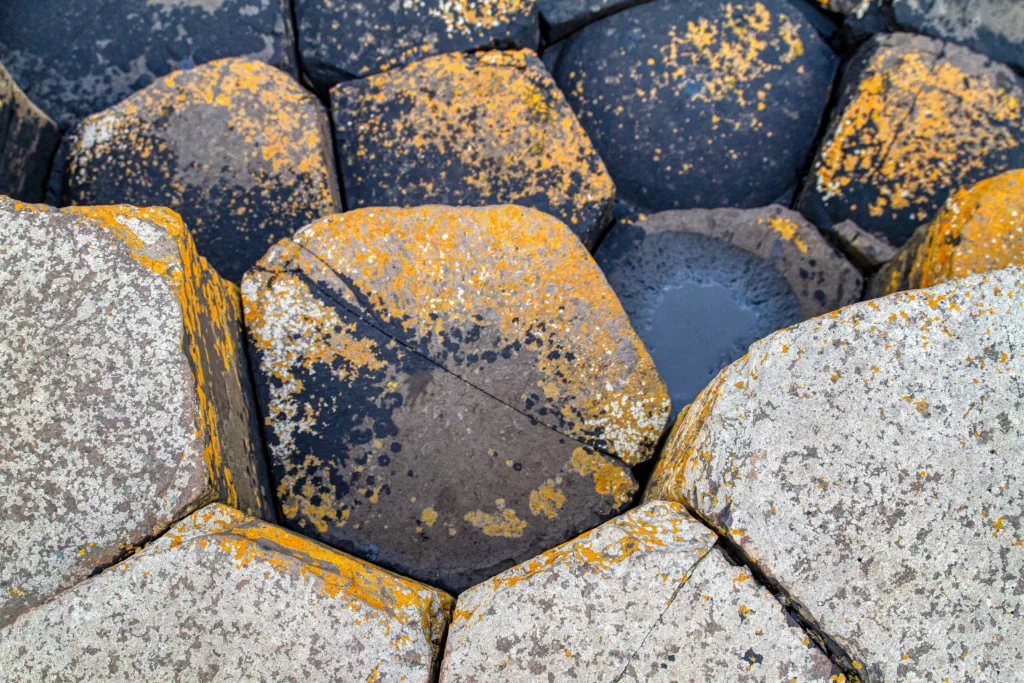Basalt is a type of igneous rock that is commonly found in volcanic areas. It is composed of various minerals, including plagioclase feldspar, pyroxene, olivine, and sometimes biotite or hornblende. Basalt is typically dark in color and has a fine-grained texture.
In terms of its mineral composition, basalt is considered a mafic rock. This means that it is rich in magnesium and iron, which are components of minerals such as pyroxene and olivine. These minerals give basalt its characteristic dark color. Mafic rocks are typically contrasted with felsic rocks, which are lighter in color and composed of different minerals.
Felsic rocks are defined as those that are primarily composed of feldspar and quartz. These minerals are light in color and have specific gravities less than 3. The most common felsic rock is granite, which is composed of quartz, orthoclase feldspar, and plagioclase feldspar. Other felsic minerals include muscovite and the sodium-rich plagioclase feldspars (albite-rich).
Given that basalt is not primarily composed of feldspar and quartz, it is not considered a felsic rock. Instead, it is classified as a mafic rock due to its high magnesium and iron content. This classification is based on the chemical and mineralogical properties of the rock, rther than its color or texture.
Basalt is not a felsic rock. While it is often dark in color and has a fine-grained texture, it is composed of different minerals than felsic rocks such as granite. Basalt is classified as a mafic rock due to its high magnesium and iron content, and it is commonly found in volcanic areas around the world.
The Mafic Nature of Basalt
Basalt is classified as a mafic rock because it is rich in magnesium (Mg) and ferric (Fe) oxides. These minerals are the primary constituents of basalt and contribute to its characteristic dark color. Mafic rocks are commonly contrasted with felsic rocks, which are light-colored and rich in minerals such as quartz and feldspar.
Mafic rocks are typically formed through volcanic processes, where magma that is rich in magnesium and iron minerals rises to the surface and solidifies. Basalt is a common type of mafic rock that is formed from the rapid cooling of lava flows on the Earth’s surface.
The presence of magnesium and iron minerals in basalt also contributes to its physical properties. Mafic rocks are typically denser and heavier than felsic rocks due to the higher concentration of thse minerals. Basalt is also harder and more durable than many other types of rocks, making it a popular material for construction and paving.
Basalt is classified as a mafic rock due to its high concentration of magnesium and ferric oxides. These minerals contribute to its dark color and unique physical properties, including density and durability.

What Types of Rocks are Felsic?
Felsic rocks are a type of igneous rock that are high in silica and aluminum content, and low in iron and magnesium. These rocks are usually light in color, ranging from white to pink, and have a lower specific gravity than mafic rocks. The term “felsic” is derived from the German word “fels” which means rock.
The most common felsic rock is granite, which is composed of quartz, feldspar, and mica. Quartz is a common mineral found in felsic rocks, and it has a distinctive glassy appearance. Feldspar is another common mineral found in felsic rocks, and it is divided into two types: orthoclase and plagioclase. Orthoclase is a potassium-rich feldspar, wile plagioclase is a sodium-rich feldspar.
Muscovite is another common mineral found in felsic rocks. It is a type of mica that has a pearly luster and often forms thin, flexible sheets. Other minerals that may be present in felsic rocks include biotite, amphibole, and pyroxene.
Here is a list of common felsic rocks:
– Granite
– Rhyolite
– Pumice
– Obsidian
– Tuff
– Dacite
– Andesite
Felsic rocks are high in silica and aluminum content, low in iron and magnesium, and are usually light in color. The most common felsic rock is granite, and common felsic minerals include quartz, feldspar, and muscovite.
Is Basalt a Felsic Extrusive Rock?
Basalt is not a felsic extrusive rock. Felsic rocks are those that are rich in silicate minerals such as Quartz, Feldspar, and Mica, and have a low density. On the other hand, basalt is a mafic extrusive rock, which means it is rich in magnesium and iron and has a high density.
Basalt is typically composed of Plagioclase feldspar (Labradorite), Pyroxene, Olivine, Biotite, Hornblende, and sometims small amounts of Quartz. These minerals give basalt its characteristic dark color and fine-grained texture.
In terms of its chemical composition, basalt is rich in silica (SiO2), but not as much as felsic rocks. Basalt typically has a silica content of around 50%, while felsic rocks can have silica content of up to 70%.
To summarize, basalt is not a felsic extrusive rock. It is a mafic extrusive rock that is rich in magnesium and iron and has a lower silica content than felsic rocks.
Is Basalt a Mafic Rock?
Basaltic rock is a type of mafic rock. The term “mafic” is used to describe rocks that are rich in magnesium and iron and crystallize from silicate minerals at high temperatures. Basalt is a common type of mafic rock that forms from the solidification of lava flows. Gabbro, another type of mafic rock, forms from the slow cooling and solidification of magma beneath the Earth’s surface.
To understand the relationship between basaltic and mafic rocks, it is important to consider the Bowen reaction series. This series describes the order in which minerals crystallize at diffrent temperatures as magma or lava cools. Mafic minerals, such as olivine and pyroxene, crystallize at higher temperatures than felsic minerals, such as quartz and feldspar.
Basaltic rocks are formed from magma or lava that is relatively low in silica content and high in magnesium and iron. This type of magma or lava has a low viscosity and can flow easily, allowing it to cover large areas before cooling and solidifying into basaltic rock.
Basaltic rock is a type of mafic rock that forms from magma or lava that is low in silica content and high in magnesium and iron. It is a product of the high-temperature range of the Bowen reaction series and is characterized by its low viscosity and ability to flow easily before solidifying.

Conclusion
Basalt is not considered felsic rock. Felsic rocks are characterized by their light color and high content of light-colored minerals such as quartz, muscovite, and sodium-rich plagioclase feldspars. In contrast, basalt is a common mafic rock composed of dark-colored minerals, including plagioclase feldspar, pyroxene, olivine, biotite, and hornblende, with less than 20% quartz. While the two types of rocks share some similarities in their mineral composition, their overall characteristics and properties differ significantly. Therefore, it is important to understand the distinction between felsic and mafic rocks when studying and classifying different types of igneous rocks.
